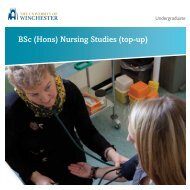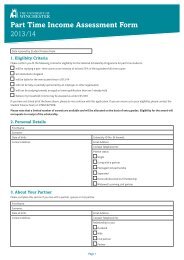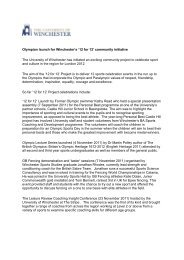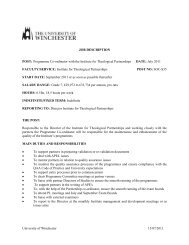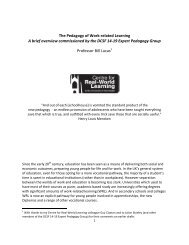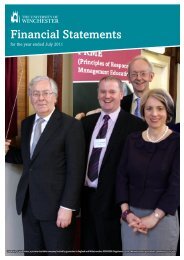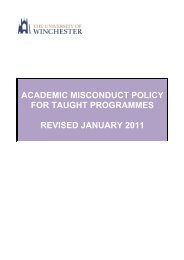Gender Equality Scheme - University of Winchester
Gender Equality Scheme - University of Winchester
Gender Equality Scheme - University of Winchester
Create successful ePaper yourself
Turn your PDF publications into a flip-book with our unique Google optimized e-Paper software.
APPENDIX 2: Summary <strong>of</strong> responses to consultation<br />
Summary <strong>of</strong> Responses to Staff Questionnaire<br />
The first group <strong>of</strong> questions (1a-7d) asked about discrimination in the staff<br />
life cycle. The majority <strong>of</strong> respondents did not identify any discrimination.<br />
Points <strong>of</strong> the life cycle which are <strong>of</strong> note and drew comment were:<br />
• at interview, a concern raised over appropriate panel membership,<br />
• job related gender assumptions e.g. “men don’t make good<br />
administrators” <strong>of</strong> those short-listing/appointing<br />
• whilst no respondents noted any discrimination against men in access &<br />
availability <strong>of</strong> training, there was some feeling <strong>of</strong> discrimination against<br />
women.<br />
• 10 respondents (12.3%) to a question on career progression felt there was<br />
discrimination against women in this area. This was re-iterated in focus<br />
groups, in particular this was a concern for female academic staff.<br />
• 10 respondents (12.5%) to a question on flexible working felt there was<br />
discrimination against women in access to flexible working. A further 8<br />
(10%) felt there was discrimination against men.<br />
• 7 respondents(8.6%) felt there was discrimination against men in access<br />
to maternity/paternity/adoption/parental leave, with one specific<br />
reference to “perinatal (sic) leave entitlement”.<br />
• No respondents felt there was discrimination against women in access to<br />
childcare facilities<br />
• In response to four questions regarding the end <strong>of</strong> employment<br />
(resignation, retirement, redundancy and university termination <strong>of</strong><br />
employment) only 4 respondents felt there was any discrimination against<br />
women or men.<br />
The second group <strong>of</strong> questions (9a-10) looked at gender inequality in support<br />
and representation <strong>of</strong> staff. Points <strong>of</strong> note and which drew comment are:<br />
• Comments regarding committee membership concerned gender balance<br />
in committees, how members are appointed to committees and regarding<br />
women’s tendency to be reticent about expressing their views.<br />
• In response to 4 different questions on access to and availability <strong>of</strong><br />
harassment contacts, university nurse, counsellors and human resources<br />
staff, a total <strong>of</strong> 10 respondents felt there was gender inequality against<br />
men. Additional comments noted a concern that men may not want to<br />
approach a female nurse or may not feel comfortable approaching a



